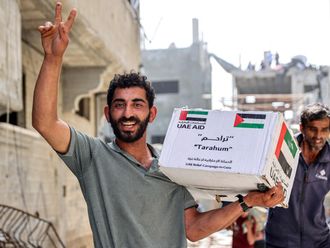BEIRUT: Since the start of Syria’s war in 2011, numerous diplomatic attempts to halt the conflict have stumbled, mainly over the future of President Bashar Al Assad.
Here is a summary of some of key initiatives:
End of Arab solutions:
In January 2012, two months after an initial bid to end the violence, leading Arab diplomats adopt a plan that would transfer power from Al Assad to a coalition cabinet.
The Damascus regime rejects the proposal, declaring “an end of Arab solutions”, and vows to crush rebel movements.
Geneva I, ambiguous formula:
On June 30, 2012 global powers meeting in Geneva draw up a plan that would install a transition government but does not spell out what would happen to Al Assad.
Among those involved in the proposal are the five permanent members of the UN Security Council — Britain, China, France, Russia and the United States — plus the Arab League, Turkey and the European Union.
They differ over what the plan really means, however, with the United States saying it paves the way to a “post-Al Assad” period.
China and Russia, allies of Al Assad, insist it is up to Syrians to decide their future.
Geneva II, no agreement:
In January 2014 the first talks between Syrian opposition groups and the government are held in Geneva under the auspices of Russia and the United States.
On February 15, after a second fruitless session, UN mediator Lakhdar Brahimi calls an end to the talks and resigns.
Russian involvement, Vienna plan
In September 2015 Russia becomes militarily involved in the Syria war. Its role becomes a game changer by helping Al Assad, whose forces have struggled against Gulf- and Western-backed rebels.
In November 2015 the International Syria Support Group (ISSG) is set up in Vienna, grouping 23 world or regional powers and multilateral organisations. They include Russia, Saudi Arabia, Turkey, the US, the United Nations, the European Union and, for the first time, key regional player Iran.
The group draws up a transition outline but the question of Al Assad’s future is still not resolved.
On December 18 the UN Security Council unanimously adopts a resolution endorsing the Vienna peace process.
Geneva: seven fruitless rounds:
In early 2016 three rounds of UN-supervised indirect negotiations are held in Geneva between regime and opposition groups. The parties do not talk face to face.
The negotiations stall over arrangements for a transition and run up against violations on the ground of a ceasefire initiated by Washington and Moscow.
In March, May and July 2017 four other rounds of indirect talks are held, without results.
A new round is scheduled for November 28 in Geneva under UN auspices.
Geneva overshadowed by Astana:
In late 2016 Russia and Iran, who back the Syrian regime, and Turkey, which backs the rebels, take over the peace process, sidelining the US.
In late December they impose a ceasefire.
In January 2017 the three sponsors organise talks in Astana, Kazakhstan, between representatives of the regime and a rebel delegation.
Seven rounds of negotiations have since taken place and have reached an accord on the setting up of four “de-escalation” zones in key areas of Syria, opening the way for a decrease in violence while not ending it completely.
The Turkish, Iranian and Russian presidents are scheduled to meet on Wednesday in the Russian resort of Sochi.
Russia has also announced it is planning to hold a broad “Congress of Syrian National Dialogue” in Sochi, although the date has yet to be set.










